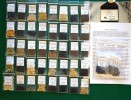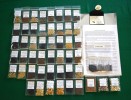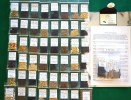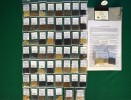Have you ever wondered how our ancestors preserved a whole winter season worth of frost-intolerant produce? Canning is a useful method, though a large harvest can easily turn it into a seemingly impossible task. The solution many generations before us turned to was building a root cellar.
INSULATION: The earth is a wonderful insulator. A typical old-world root cellar was literally buried on all sides except the entrance, utilizing the natural insulating properties of the soil.
VENTILATION: It is important that your make-shift root cellar can breathe. Warm stale air needs to float out of the top of your chamber as fresh cooler air makes its way through the bottom. This is important to keep humidity levels under control in order to prevent the rot of moisture-sensitive vegetables such as squashes.
DARKNESS: Light accelerates the decomposition of fruits and vegetables, so an ideal means of storage incorporates complete darkness.
Consider what you may have on hand if you would like to construct a practical yet permanent root cellar:
Burying an insulated plastic or metal trash can with a tight lid is a popular option. Others have gone to the trouble of recycling an entire broken refrigerator by submerging it in a hillside. Another option is to frame off a corner of your basement with a window or vent. A more conservative approach is to sink a large cooler into the ground. If one of these avenues are chosen, make sure you are ventilating with a hose or pipe.
A blast valve or similar device may be incorporated to prevent below freezing temperatures from entering your storage compartment.
My personal favorite involves little more than a pile of straw, hay, leaves, or moss and a minimal amount of elbow grease. It is most effective with potatoes (Read on).
As a rule of thumb make sure not to wash any produce prior to storing. This will greatly reduce its ability to keep. Instead provide enough drying time for exterior dirt to dehydrate, then brush off any large clumps.
Apples can be a dangerous food to store with other produce. The idiom one rotten apple spoils the barrel is spot on. As apples age they release ethylene gas which causes other produce to rot too. It’s a wise practice to isolate them in shallow containers with lids. They keep best in 80-90% relative humidity and prefer temperatures of 32-40 degrees Fahrenheit. Check on them often and remove any signs of rot.
Beets prefer the same 32–40-degree temperature range but can withstand a bit more humidity. Outdoor storage is an easy and effective method to practice. Before hard frosts begin simply hoe dirt over the protruding shoulders keeping the foliage exposed. As winter begins, mulch over the rows with up to a foot (more for colder climates, less for warmer) of leaves, straw, or hay.
This method may be applied to carrots, parsnips, turnips, celery, rutabagas, cabbages, leeks, kale, and spinach with some success as well. Regarding flavor, the longer you can keep cold tolerant produce in the ground, the better. Cool fall temperatures sweeten many vegetables such as beets by literally increasing the presence of sugar.
Brussels sprouts are somewhat frost hardy and can be left in the garden until late fall. They may be kept in a root cellar for some time however a lack of moisture will shorten their lifespan. Like beets they prefer a temperature range of 32-40 degrees and high relative humidity of 90-95%.
Cabbage can withstand light frost when it is young and moderately severe frost when mature. Some varieties are briefly tolerant to temperatures as low as 20 degrees. The method of mulching beets above can be employed here. Cabbage prefers cold temperatures of 32 to 40 degrees and high moisture of about 80-95% relative humidity making it a good root cellar candidate. Either cut off the head or pull out the entire plant (roots included). If the roots are left on it may last a bit longer in a cellar, however if the stump is left in the ground a smaller leafy cabbage will emerge the following season.
Carrots can be kept in the garden under mulch just like beets. Remember to cover the shoulders with dirt. They prefer temperatures of 32-40 degrees and relative humidity of 90-95% in a root cellar. If storing in a cellar, harvest before the soil freezes, cut the stems close to the carrot, and store in a bucket of leaves or sawdust with a loose lid.
Cauliflower and Celery prefer cold temperatures of 32-40 degrees Fahrenheit and very moist relative humidity of 90-95%.
Celeriac is one of the best keeping vegetables during the winter months. Trim off the longer roots making sure not to cut too close to the meat. Store it in damp sawdust, sand, or moss at an ideal temperature range of 32-40 degrees and a very moist relative humidity of 90-95%.
Dry Beans can be harvested after pods are nearly dried out while still attached to the vine. Spread the pods on newspaper for a week or two until completely dry. A productive trick to separate the beans from the pods is to fill a bag and beat it with a stick. When a hole is cut in the bottom corner the beans will fall out pod-free. Dry beans store well in temperatures between 32-50 degrees though they can withstand freezing temperatures. They are less moisture tolerant at an ideal range of 60-70% relative humidity. Store in dry containers with tight lids.
Garlic needs to be air dried in a warm arid area for 2-3 weeks. Remove the roots and store at an ideal 32-50 degrees with 60-70% relative humidity and good airflow.
Leeks come in frost hardy varieties which should be utilized if growing for storage. They can withstand a bit of snow and the mulching process may be used up until the ground freezes. Harvest with some roots still attached and stored at an ideal 32-40 degrees upright, preferably in wet sand. Though leeks prefer a high relative humidity of 90-95% take care not to wet the leaves during storage.
Onions require curing until the necks are quite tight before storing. To cure, spread them in a dry area with sufficient airflow or hang them upside down. Ideal storage temperatures range from 32-50 degrees with a relative humidity of 60-70%. Make sure they are stored in an breathable container such as crates or mesh bags.
Parsnips store well in uncovered ground until a solid freeze at which point they should be mulched. The frost improves their flavor for a succulent spring harvest. Store harvested parsnips in damp sawdust at an ideal 32-40 degrees and a high relative humidity of 90-95%.
Potatoes should be cured in a dark place for 1-2 weeks at 45-60 degrees. After this they prefer cold temperatures of 32-40 degrees and moist relative humidity of 80-90%. A great means of outdoor storage is piling an insulating material such as straw or hay on top of unused winter garden space with a few inches of dirt on top. Make sure to keep a ventilation hole, clear of dirt, on one side of the pile and a drainage ditch around the perimeter equipped with a small runoff canal.
Throughout the winter hungry gardeners can reach through the ventilation hole and fish out the produce. If you have a tarp on hand covering the top of the pile, but not the ventilation hole, will prevent your storage mound from eroding away. If many potatoes need storing and more than one pile is not an option layer the pile with 4-6 inches of insulating medium, followed by a single layer of potatoes, followed by 4 inches of soil. Repeat the layering process.
Pumpkins should be cured like squash (see below) with the stem left attached and stored around 50-55 degrees. Relative humidity should fall between 60-75%
Sweet Potatoes can be preserved all the way until spring if properly cured and stored. To cure, let air-dry in a warm humid environment of 80-85 degrees and 90% relative humidity for 10-14 days. This will toughen the skin and improve the flavor. Sweet Potatoes store best in an unheated room of about 50-60 degrees with a moderate relative humidity of 60-70% taking great care not to let them drop below 50 degrees.
Turnips should be harvested before heavy frosts, tops removed, and stored as you would carrots in a moist insulator such as sawdust, moss, or sand.
Winter Squash should be harvested before a hard frost when the skin is tough enough to prevent penetration from a moderately pressed thumb nail. Flavor is best when the seeds are given a chance to fully develop. Make sure to leave the stem on the fruit and cure for about 10 days at 75-85 degrees, ideally. Store them in a moderately dry and warm spot where the temperature doesn’t drop below 50 and preferably stays below 60 degrees. The best relative humidity for storage falls between 60-70%. This great information was by Farmacy.
When you are ready for some great, small, farm-grown Heirloom seeds for your greenhouse, take a look at our 60 Variety Heirloom Seed Package that has over 32,000 seeds and is currently priced on-sale at just $79. You get 49 Heirloom vegetable seed varieties along with 11 Heirloom herb seed varieties all snuggled into a nice-sized Mylar for year-to-year or long-term storage. What a great gift for that person you know who loves to garden!
We’ve recently updated to a new SEED GUY website https://theseedguy.net that is faster, mobile friendly, and offers our customers more ways to pay; Credit Cards, Paypal, Paypal Pay Later, and Apple Pay.
We’d love to have you follow us on Facebook, so click the LIKE at the top of our Facebook page at https://www.facebook.com/theseedguy and you’ll be able to see more of our gardening articles and new seed offerings and sales. Thank you and God bless you and your family!!




















